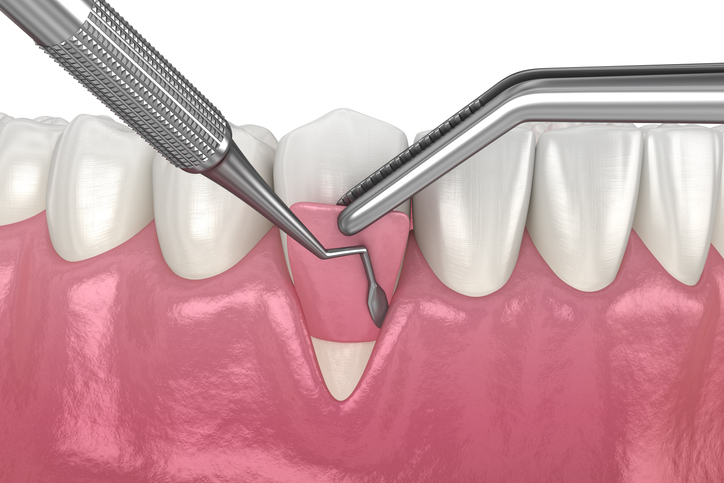
It is important to seek treatment for gum recession as soon as possible to prevent further damage to your teeth and gums. We are here to help you understand the causes of gum recession and the treatment options available to you.
In the following sections, we will discuss how gum recession is diagnosed, the different treatment options available, what to expect during and after the procedure, and how to care for your gums after treatment.
Diagnosis and Treatment Options
Gum recession is a common dental problem that can lead to tooth sensitivity, decay, and even tooth loss if left untreated. If you suspect that you have gum recession, it’s important to seek treatment as soon as possible.
During your consultation we will examine your gums and teeth to determine the extent of the recession. We may also take X-rays to check for bone loss and other underlying issues.
Once we have diagnosed your gum recession, we will discuss the different treatment options available. These may include:
- Scaling and root planing: This is a non-surgical treatment that involves removing plaque and tartar from the teeth and roots, and smoothing the root surfaces to help the gums reattach to the teeth.
- Gum grafting: This is a surgical procedure that involves taking tissue from another part of your mouth or using donor tissue to cover the exposed root and restore the gum line.
- Pinhole surgical technique: This is a minimally invasive procedure that involves making a small hole in the gum tissue and using special instruments to gently move the gum tissue back into place.
Each treatment option has its own pros and cons, and we will work with you to determine the best course of action based on your individual needs and preferences.
Remember, early diagnosis and treatment of gum recession can help prevent further damage and improve your overall oral health.
Preparing for the Procedure
Before undergoing any dental procedure, it is important to know what to expect and how to prepare. When it comes to gum recession treatment, there are a few things you should keep in mind.
First, you will need to schedule a consultation. During this appointment, we will examine your gums and determine the best course of treatment for your specific case. We may take x-rays or other diagnostic tests to get a better look at your teeth and gums.
Before the procedure, we will provide you with pre-operative instructions to follow. This may include avoiding certain foods or medications, or adjusting your oral hygiene routine. It is important to follow these instructions carefully to ensure the best possible outcome.
On the day of the procedure, you should plan to arrive at our office a few minutes early. Be sure to bring any necessary paperwork or insurance information with you. You may also want to bring a friend or family member to drive you home after the procedure, as you may feel a bit groggy from any sedation used during the procedure.
By following these simple steps, you can ensure that you are fully prepared for your gum recession treatment!
The Procedure
We understand that undergoing any dental procedure can be nerve-wracking. That’s why we want to make sure you feel comfortable and informed about what to expect during your gum recession treatment.
The procedure typically involves removing the affected gum tissue and then grafting new tissue onto the area. This can be done using tissue from your own mouth or from a donor source. The graft is then secured in place with sutures.
During the procedure, you will be given local anesthesia to numb the area. You may feel some pressure or discomfort, but it should not be painful. After the procedure, you may experience some swelling and discomfort, but this can be managed with over-the-counter pain medication and ice packs.
It’s important to follow all post-operative instructions provided by our team to ensure proper healing. This may include avoiding certain foods, using a special mouthwash, and avoiding smoking or tobacco use.
If you experience any complications or have concerns during the healing process, don’t hesitate to contact us. We are here to support you and ensure the best possible outcome for your gum recession treatment.
Aftercare and Follow-up
After undergoing gum recession treatment, it is important to follow post-operative instructions to ensure proper healing and prevent complications. Our team will provide you with detailed instructions on how to care for your gums after the procedure.
It is important to avoid brushing or flossing the treated area for the first 24 hours after the procedure. After that, you can resume gentle brushing and flossing, but be sure to avoid the treated area until it has fully healed.
You may experience some discomfort or swelling after the procedure, but this can be managed with over-the-counter pain medication and ice packs. It is important to avoid smoking and drinking alcohol during the healing process, as these can delay healing and increase the risk of complications.
We will schedule follow-up appointments to monitor your healing progress and ensure that the treatment was successful. It is important to attend these appointments and follow any additional instructions provided.
Proper aftercare and follow-up are crucial for the success of gum recession treatment. If you have any questions or concerns during the healing process, do not hesitate to contact us. We are here to support you every step of the way. If you are experiencing gum recession, schedule a consultation to discuss your treatment options and take the first step towards a healthier smile.
